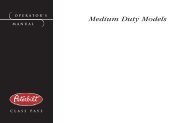Peterbilt Model 320 Operator's Manual after 8-07 - Peterbilt Motors ...
Peterbilt Model 320 Operator's Manual after 8-07 - Peterbilt Motors ...
Peterbilt Model 320 Operator's Manual after 8-07 - Peterbilt Motors ...
You also want an ePaper? Increase the reach of your titles
YUMPU automatically turns print PDFs into web optimized ePapers that Google loves.
PART 7: STARTING & OPERATING THE VEHICLE<br />
Operating the Clutch<br />
“Riding” the Clutch<br />
The clutch pedal is not a footrest. Driving with your foot<br />
on the clutch pedal will allow your clutch to slip, causing<br />
excessive heat and wear. You can damage your vehicle<br />
this way.<br />
Clutch Travel<br />
CAUTION: Always use firstgearoralowspeed<br />
range to start the vehicle in motion. The use<br />
of a higher gear or speed range forces undue<br />
strain on the engine, clutch, other transmission<br />
components, and may cause damage.<br />
To put your vehicle into motion, push down on the clutch<br />
pedal until the clutch brake makes contact. This contact<br />
will occur at about 1/2 inch to 1 inch from the end of pedal<br />
stroke. Select a gear low enough to let your vehicle start<br />
forward with the throttle at idle until the clutch is fully engaged.<br />
The total stroke of the clutch pedal is about 10 inches. The<br />
first 1 3/4 to 2 inches is free travel. After that is the release<br />
stroke, the part that fully releases the clutch. The last 1/2<br />
Operating the Clutch<br />
to 1 inch engages the clutch brake. If your vehicle is new,<br />
watch the free travel in your clutch carefully for the first few<br />
hundred miles. As your clutch lining wears and high spots<br />
get worn smooth, you will get less free travel.<br />
Always start out in a low gear with a ceramic-faced clutch.<br />
Starting in higher gears, even with a light load, will cause a<br />
very jumpy start and excessive wear.<br />
And don’t allow your vehicle to roll in the opposite direction<br />
at all during clutch engagement. If you need to start up on<br />
an incline, apply your service brakes before you release<br />
the parking brake. Then release your service brakes as<br />
you engage the clutch and apply throttle.<br />
Release Bearing Wear<br />
When you must idle your engine for any period of time, shift<br />
your transmission to neutral and engage the clutch (take<br />
your foot off the pedal). This helps prevent unnecessary<br />
wear of your clutch release bearing. And it is less tiring for<br />
you, too.<br />
Clutch Adjustment<br />
Inspect manual and self-adjusting clutches regularly to<br />
maintain correct clutch adjustment. Have your dealer’s<br />
R(08/<strong>07</strong>) Y53-6015 – 79 –
















